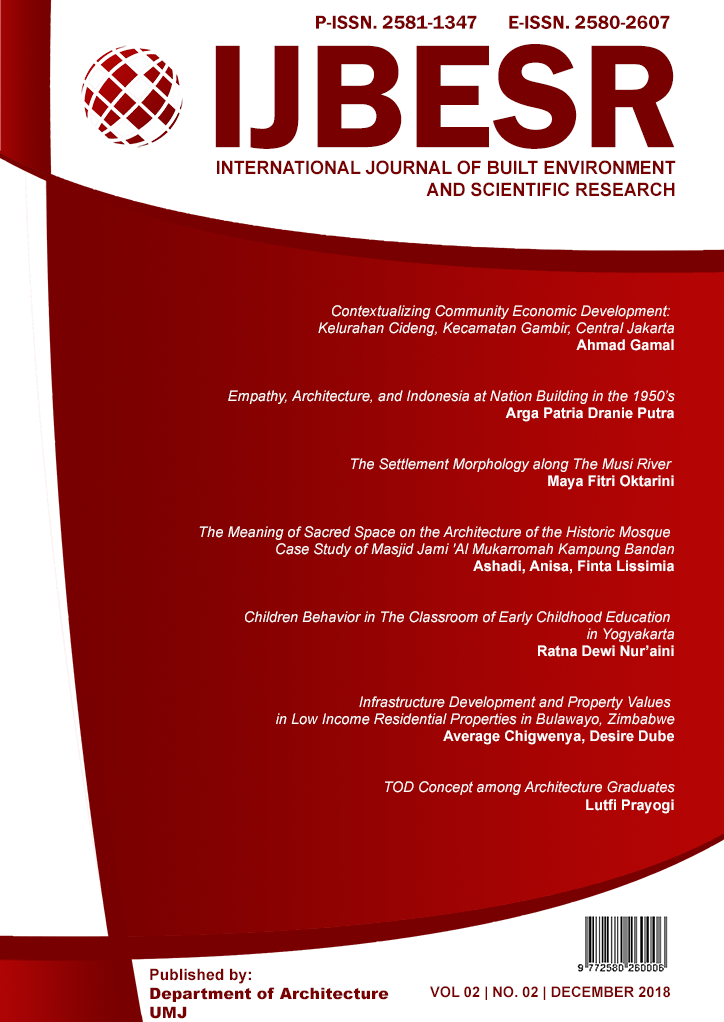The Settlement Morphology along The Musi River
DOI:
https://doi.org/10.24853/ijbesr.2.2.97-104Keywords:
Morphology, Settlement, and Musi RiverAbstract
The study examines the morphology of the settements along the Musi riverbank and focuses on the association between the settlements morphology and the characteristic of the river. Musi River consists of three river zones, i.e. upstream, middle, and downstream. The specific morphology that was studied is the distance of the buffer area, the building orientation, and the housing typology that were compared to the physical characteristics of the river and the socio-cultural of the communities. The study data was collected through satellite map and field survey on three settlement sites for each zone, including maps, sketches, photographs, and interviews. The results show the main factors influencing the settlement morphology is the community's dependent on the river. The function of the river for daily life activities influences the distance and the orientation of the settlements. The more the functions of the river for the daily life, the closer and the more oriented their settlements are to the river. Therefore, the river disasters, such as flood and erosion should keep the settlement away from the riverbank. However, the dependence on the river creates the adaptation to on building the settlements that adapt to the natural cycle. It also establishes the morphology of the settlements on the riverbank.References
Shannon, Kelly. Eco-Engineering for Water: From Soft to Hard and Back. In Resilience in Ecology and Urban Design, S.T.A. Pickett, M.L. Cadenasso, and Brian McGrath, eds. Future City. Dordrecht: Springer Netherlands; 2013, p. 163–182.
Yodsurang, Patiphol, Miki Hiromi, and Uekita Yasufumi. A Traditional Community in the Chao Phraya River Basin: Classification and Characteristics of a Waterfront Community Complex. Asian Culture and History; 2015, 8(1): 57.
Papayannis, Thymio, Dave Pritchard, and Mediterranean Institute for Nature and Anthropos. Culture and Wetlands in the Mediterranean: An Evolving Story. Athens: Med-INA; 2011.
Groffman, Peter M., Daniel J. Bain, Lawrence E. Band, et al. Down by the Riverside: Urban Riparian Ecology. Front Ecol Environ; 2003, 1(6): 315–321.
Mentayani, Ira. Transformasi Adaptif Permukiman Tepi Sungai di Kota Banjarmasin Kasus: Barito-Muara Kuin, Martapura, dan Alalak, Universitas Gadja Mada; 2015.
Anwar, Widya Fransiska. Identification of the Morphological Characteristic of Palembang Riverside Settlement. Universiti Teknologi Malaysia; 2013.
Naing, Naidah, and Haryanto Halim. Sistem Struktur Rumah Mengapung di Danau Tempe Sulawesi Selatan Structure System of Floating House at Tempe Lake in South Sulawesi. Jurnal Permukiman; 2013; 8(3), p.143–152.
Denpaiboon, Chaweewan. Transformation by Modernization of the Traditional Waterfront Settlements in the Context of Their Coexistence with Aquatic Environment: A Case Study of Raft House and Pillar House in Thailand. Kyoto University; 2001.
Samuel; Susilo Adjie. Zonasi, Karakteristik Fisika-Kimia Air dan Jenis-Jenis Ikan yang Tertangkap di Sungai Musi, Sumatera Selatan (Zonation, Physio-chemical Characteristic of Water and Fish species of Musi River). Jurnal Ilmu-Ilmu Perairan dan Perikanan Indonesia; 2008; 15(1), p.41–48.
Santun, Dedi Irwanto Muhammad, Murni, and Supriyanto. Ilirin Dan Uluan: Dinamika Dan Dikotomi Sejarah Kultural Palembang. Yogyakarta: Eja Publisher; 2010.
Nurhan, Kenedi. (2010). Jelajah Musi: Eksotika Sungai di Ujung Senja. Jakarta: PT. Gramedia. 2018.
Pinke, Zsolt, László Ferenczi, Gyula Gábris, and Balázs Nagy. Settlement Patterns as Indicators of Water Level Rising? Case Study on the Wetlands of the Great Hungarian Plain. Quaternary International; 2016; 415, p. 204–215.
Hawes, Ellen, and Markelle Smith. Riparian Buffer Zones: Functions and Recommended Widths. Eightmile River Wild and Scenic Study Committee; 2005; 15.
Thaitakoo, Danai, and Brian McGrath. Changing Landscape, Changing Climate: Bangkok and the Chao Phraya River Delta. Places; 2008; 20(1), p.30–35.







